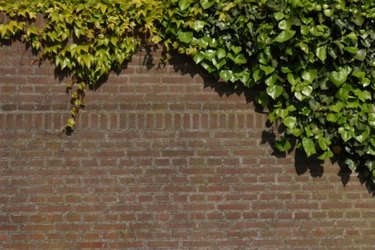
English ivy, Irish ivy, scarlet gourd, Kudzu and other vine plants offer attractive vegetation for home gardens and landscapes. Depending on the climate, such plants offer a natural habitat and fodder for wildlife. Unfortunately, such plants also provide a home to unwanted pests, rodents, reptiles and insects. Before planting or allowing wild vines to grow, knowledge of the associated lifeforms these plants attract helps prevent unwanted infestations.
What is Attractive About Ivy or Vines?
Video of the Day
Different ivies and vine plants offer different attributes that attract various things. Some flower, attracting bees and other flying insects to help with pollination. Others produce juicy leaves as fodder for wildlife. What makes ivy and other vine plants so attractive as a habitat is also sometimes what makes these plants attractive in gardens and landscapes. Most vine plants grow rapidly over a variety of surfaces, from trees to concrete walls, spreading a lush carpet of greenery and shade. On top, insects and wildlife feed on various plant parts. Under the surface, insects and other lifeforms have shelter from predators and direct sunlight.
Video of the Day
Beneficial Inhabitants
In addition to attracting bees and flying insects to aid in pollination, ivy and other vine plants attract a good number of beneficial inhabitants. For example, many gardeners and landscapers plant vines to attract lizards. Certain types of lizards feed on infectious insects that harm other plants in the garden. Vine plants offer a host of crevices and sheltered areas for lizards to call home. Out of the heat, hidden from predators like birds, lizards can lie in wait for insects on which to feed.
Insects and Pests
On the other side of the equation, ivy and vine plants also attract unwanted pests. Beatles, spiders, aphids and weevils are but a few insects that inhabit a mat of ivy or a wall of vines. Each climate region has its own species of plants and subsequent insects that call such plants home. In some cases, the insects who live in such plants also kill the habitat by feeding on leaves and stems.
The Micronesian island of Saipan used such tactics for natural plant control. Officials introduced populations of leaf mining and gall weevils, as well as stem borers, to deliberately infest acres of scarlet gourd vines. Deemed a noxious weed on the island, the spread of scarlet gourd decreased with the release of weevils and stem borers. Each insect lives within the vines, feeding on various leaves and stems until the plants die.
Rodents and Similar Pests
Aside from beneficial lizards and pesky insects, other wildlife enjoy creating a home under the cover of vines or ivy. In the wild, mats of vine plants offer rodents and other small wildlife the ability to hide burrow holes and nests. In the state of Washington, for example, mats of ivy growing in the wild offer a natural habitat for Norway rats. Such rodents, also known as sewer rats, can encroach on suburban areas where forests and dense vegetation edge residential living spaces. The rats use the cover offered by vine plants to hide burrows, as well as use the vines to climb when foraging for food.